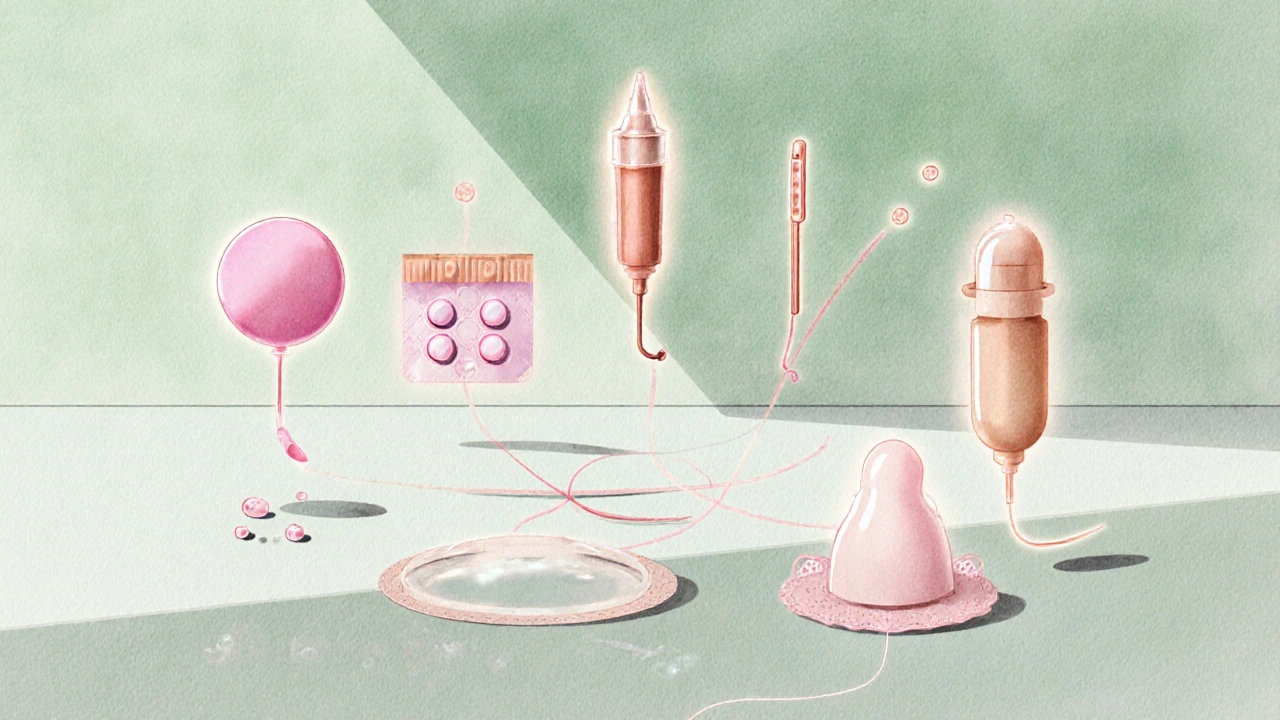Contraception & Infertility: Myths vs Facts Explained

Contraception & Fertility Timeline Calculator
Fertility Return Timeline
| Method | Return to Fertility |
|---|---|
| Combined Oral Pill | 1–3 cycles (~1–3 months) |
| Progestin-Only Pill | 1–3 cycles |
| Depo-Provera Injection | 6–10 months |
| Hormonal IUD | 1–2 cycles |
| Copper IUD | Immediate to 1 cycle |
| Implant (Nexplanon) | 1 month |
| Male Condom | Immediate |
| Diaphragm | Immediate |
| Natural Family Planning | Immediate |
Ever heard that the pill can make you sterile or that an IUD ruins your chances of getting pregnant? Those ideas pop up all the time, but the reality is far less dramatic. Below we separate the most common myths from the facts, show how each method actually works, and give a clear picture of what to expect when you stop using birth control.
Myth‑busting: the most heard rumors
- Myth: Hormonal birth control causes permanent infertility.
- Myth: Copper IUDs block sperm forever.
- Myth: The longer you use any contraceptive, the harder it gets to conceive later.
- Myth: Stopping the pill means you’ll get pregnant right away.
- Myth: Natural family planning is as reliable as the pill.
All of these are rooted in misunderstanding, fear, or outdated data. Let’s look at the facts.
What is contraception and infertility?
In simple terms, contraception refers to any method that prevents pregnancy, while infertility describes the difficulty or inability to achieve a pregnancy after a year of regular, unprotected sex. The two topics intersect because many people wonder whether the tools they use to prevent pregnancy might also make it harder to become pregnant later.
How contraception works - a quick primer
Different methods intervene at different points in the reproductive process. Understanding the basics helps demystify how they affect fertility.
- Hormonal contraceptives - contain synthetic hormones that stop ovulation, thicken cervical mucus, or thin the uterine lining.
- Barrier methods - block sperm from reaching the egg.
- Intrauterine devices (IUDs) - sit inside the uterus, either releasing copper ions or a low dose of progestin to impair sperm movement and prevent implantation.
- Implants - a tiny rod placed under the skin that releases progestin continuously.
None of these mechanisms permanently alter the ovaries, fallopian tubes, or uterus. They are reversible, meaning normal function typically returns after the method is stopped.
Hormonal methods and fertility
Combined oral contraceptives (the pill, patch, or vaginal ring) keep the body from releasing an egg. When you finish a pack, the hormone levels drop, and the ovaries start working again. Most studies show that 80‑90% of users conceive within a year after stopping, and the average time to conception is about three months.
Progestin‑only pills work similarly, though they may cause a slightly longer gap for some women because the body needs extra time to re‑establish a regular cycle.
The injectable Depo‑Provera (medroxyprogesterone acetate) is a special case. Its hormone stays in the body for up to 12weeks, and some women experience a delay of 6‑10months before ovulation resumes. The delay is not permanent; fertility returns once the hormone clears.

Barrier methods - do they harm fertility?
Condoms, diaphragms, and cervical caps are completely reversible. They never touch the ovaries or affect hormone levels, so there’s no biologically based reason for a delay in getting pregnant after they’re removed. The only “impact” can be a higher rate of unintended pregnancy if they’re used incorrectly, which is a user‑error issue, not a fertility issue.
What about IUDs?
There are two main types:
- Copper IUDs - copper creates a hostile environment for sperm. When the device is taken out, fertility usually returns within one to three menstrual cycles.
- Hormonal IUDs - release a low dose of progestin. After removal, it may take one to two cycles for normal ovulation to resume, but most women conceive quickly.
Both types are reversible and have not been linked to long‑term infertility.
Implants and subdermal devices
The implant (often known by the brand name Nexplanon) releases progestin for up to three years. When it’s removed, hormone levels fall rapidly, and ovulation typically returns within a month. A large U.S. study reported a 92% conception rate within a year of removal.
Natural family planning (NFP)
NFP relies on tracking fertility signs - temperature, cervical mucus, or hormone kits - to avoid sex on fertile days. When used perfectly, it’s as effective as some hormonal methods. Because it never introduces hormones or devices, there’s absolutely no impact on future fertility.

Return‑to‑fertility timeline - quick reference
| Contraceptive method | Type | How it works | Average return to fertility |
|---|---|---|---|
| Combined oral pill | Hormonal | Stops ovulation, thickens mucus | 1‑3 cycles (≈1‑3 months) |
| Progestin‑only pill | Hormonal | Thickens mucus, may suppress ovulation | 1‑3 cycles |
| Depo‑Provera injection | Hormonal | Suppresses ovulation for 12 weeks per dose | 6‑10 months |
| Hormonal IUD (e.g., Mirena) | Hormonal | Thickens mucus, thins lining | 1‑2 cycles |
| Copper IUD | Non‑hormonal | Copper toxic to sperm | Immediate to 1 cycle |
| Implant (Nexplanon) | Hormonal | Continuous progestin release | 1 month |
| Male condom | Barrier | Physically blocks sperm | Immediate |
| Diaphragm | Barrier | Blocks sperm entry | Immediate |
| Natural family planning | Behavioral | Times intercourse to avoid fertile days | Immediate |
These numbers come from recent cohort studies (2023‑2024) that followed thousands of women after they stopped using each method. “Average” means most women fall within this window, but individual experiences can vary.
Factors that truly affect infertility
While contraception itself isn’t a cause of long‑term infertility, many other factors do play a role:
- Age - fertility naturally declines after the early 30s.
- Underlying health conditions - polycystic ovary syndrome (PCOS), endometriosis, thyroid disorders.
- Lifestyle - smoking, excessive alcohol, high stress, extreme weight changes.
- Male factors - low sperm count, motility issues, varicocele.
- Environmental exposures - certain chemicals, radiation.
When you’re planning a pregnancy, address these elements alongside whatever contraceptive you’ve been using.
Tips for a smooth transition from birth control to trying for a baby
- Schedule a pre‑conception check‑up. Your doctor can run basic labs and discuss any health concerns.
- Take a multivitamin with folic acid now - it’s safe with most methods and prepares your body for pregnancy.
- If you were on Depo‑Provera, consider a short‑term bridge method (e.g., condoms) while you wait for fertility to return.
- Track your cycle for a few months after stopping. Even if you’re on a fast‑return method, it helps you know when you’re ovulating.
- Maintain a healthy diet, stay active, and avoid smoking or heavy drinking. These habits boost both male and female fertility.
Remember, a brief waiting period is normal. Most couples conceive within six months of regular, unprotected sex if both partners are healthy.
Key takeaways
- Modern contraceptives do not cause permanent infertility.
- Most methods let fertility bounce back within a few months; only the injection may take up to a year.
- Barrier methods and IUDs have almost immediate return to fertility.
- Real infertility risks are linked to age, health conditions, and lifestyle, not birth control.
- Planning a pregnancy after stopping contraception is easiest with a pre‑conception check‑up and healthy habits.
Frequently Asked Questions
Does using birth control cause permanent infertility?
No. All FDA‑approved contraceptives are reversible. Fertility usually returns within weeks to months after the method is stopped, depending on the type.
How long does it typically take to get pregnant after stopping the pill?
For combined or progestin‑only pills, most women ovulate within one to three menstrual cycles. About 80‑90% conceive within a year.
Will a copper IUD affect my future chances of getting pregnant?
No. The copper IUD works only while it’s in place. Once removed, fertility returns almost immediately - often within the first cycle.
Why does the Depo‑Provera injection sometimes delay pregnancy?
The injection releases a hormone that stays in the bloodstream for up to 12 weeks per dose. It can suppress ovulation for several months after the last shot, leading to a typical 6‑10‑month waiting period.
Are there any contraceptives that actually improve fertility?
None directly improve fertility, but methods that don’t disturb hormone levels (like condoms, copper IUD, or natural family planning) avoid any temporary delay, giving the quickest path to conception once you stop using them.



Sarah Brown
Listen up, there's a ton of myth‑fuelled nonsense about birth control turning you sterile, and I'm here to crush it with hard facts. The data shows that every FDA‑approved method is fully reversible, so you’re not signing a lifelong contract with a pill or an IUD. If you stop the combined oral pill, most women get back to ovulating within one to three cycles – that’s roughly a month or two, not a decade. Even the Depo‑Provera injection, which lags a bit, usually lets fertility bounce back within ten months at the worst. So quit letting fear dictate your family‑planning choices; the science is crystal clear: contraception does not equal infertility.
Max Canning
Whoa, that hits the nail on the head! 🙌 Totally agree – no need to panic, just plan smart and move forward.
Nick Rogers
The primary takeaway is that hormonal methods temporarily suppress ovulation, yet normal function resumes promptly after cessation; statistically, 80‑90% of users conceive within a year, a reassuring figure for prospective parents.
Melissa Young
Yo, let’s cut the crap – the U.S. healthcare system already pushes birth control like a free‑for‑all, and the idea that any method messes up your future kids is straight‑up junk. Hormone‑packed pills, IUDs, whatever – they’re engineered to be reversible, not to lock you out of motherhood forever. The only real ‘risk’ is dodging the facts and buying into fear mongering. Grab the data, not the myths.
SHASHIKANT YADAV
Interesting stuff! 🤔 I’ve seen a lot of people confused about the timeline after stopping Depo‑Provera – the hormone hangs around for months, so a bit of patience helps. Also, tracking your cycle with a simple app can show you when ovulation returns, which takes the guesswork out of the equation. Happy to see a clear breakdown!
Ryan Pitt
Great overview! Keeping a healthy lifestyle alongside a pre‑conception check‑up can make that return to fertility even smoother. Remember, vitamins and staying active are your allies.
Jami Johnson
When we confront the swirling sea of misinformation surrounding contraception, it becomes imperative to dissect each claim with surgical precision, for the stakes are nothing less than the reproductive autonomy of countless individuals. First, the notion that hormonal birth control inflicts permanent sterility is a myth that has persisted despite a mountain of peer‑reviewed evidence demonstrating full reversibility across all FDA‑approved products. Second, the copper IUD, often maligned as a permanent barrier, in reality ceases its spermicidal activity the moment it is removed, allowing the uterus to resume its natural receptivity within a single menstrual cycle. Third, the injectable Depo‑Provera, while possessing a longer pharmacokinetic tail, does not impair the ovarian reserve; it merely postpones the resumption of ovulation until serum medroxyprogesterone levels fall below the suppressive threshold, a process that statistically spans six to ten months. Fourth, barrier methods-condoms, diaphragms, cervical caps-operate devoid of hormonal interaction, ensuring immediate fertility restoration upon discontinuation. Fifth, the hormonal IUD, such as Mirena, releases a modest dose of levonorgestrel, which thins the endometrial lining and thickens cervical mucus, yet normal endometrial proliferation recovers typically within one to two cycles after extraction. Sixth, the sub‑dermal implant Nexplanon, delivering steady progestin, withdraws its influence swiftly once explanted, with ovulatory cycles often re‑emerging within a month. Seventh, natural family planning, grounded in the vigilant observation of basal body temperature and cervical mucus, never interferes with physiological processes, guaranteeing an instantaneous return to fertile potential. Eighth, the collective data underscore that the true culprits of lasting infertility lie elsewhere: advancing maternal age, underlying endometriosis, polycystic ovary syndrome, lifestyle factors such as smoking, excessive alcohol consumption, and environmental toxins, all of which exert a far more profound impact than any reversible contraceptive. Ninth, addressing these variables through comprehensive health assessments, nutritional optimization, and stress management can markedly improve the odds of conception. Tenth, the average time to pregnancy after cessation of most methods remains under three months, reinforcing the notion that women need not endure prolonged waiting periods. Eleventh, for those utilizing Depo‑Provera, a strategic bridge of barrier methods during the hormone washout phase can preserve pregnancy intentions without compromising safety. Twelfth, pre‑conception folic acid supplementation is universally recommended, irrespective of prior contraceptive use, to reduce neural‑tube defect risk. Thirteenth, interdisciplinary collaboration among obstetricians, reproductive endocrinologists, and primary care providers ensures personalized guidance. Fourteenth, community education initiatives that dispel these myths empower individuals to make informed decisions free from fear. Fifteenth, the narrative surrounding contraception must shift from alarmist rhetoric to evidence‑based reassurance, fostering a climate where reproductive choices are supported rather than stigmatized. In sum, modern contraceptives are allies, not adversaries, in the journey toward parenthood, provided we navigate their use with knowledge, patience, and proactive health stewardship.
Kasey Krug
Nice summary.
jake cole
The whole "pill makes you sterile" narrative is pure propaganda, and anyone still buying into it is either gullible or intentionally misinformed. Wake up and read the studies.
Natalie Goldswain
i cant believe how many ppl still think iuds are a death sentence for babies. tbh its just a tool.
khajohnsak Mankit
Like a tapestry woven from threads of science and myth, the discussion around contraception invites us to contemplate the delicate balance between control and freedom-each method a hue, each myth a shadow that fades when illuminated by data.
Jayant Paliwal
Let us consider, in a meticulous fashion, the chronological progression of hormonal influence upon the hypothalamic‑pituitary‑ovarian axis; indeed, the depots of medroxyprogesterone linger, eliciting a temporal postponement of gonadotropin release-a phenomenon well‑documented within the annals of reproductive endocrinology; consequently, the clinician must advise a patient of the statistical expectancy-approximately six to ten months-during which ovulatory emergence remains subdued-however, this interval does not constitute a pathological alteration, merely a pharmacodynamic latency; moreover, the copper IUD, devoid of systemic hormonal activity, offers an immediate reinstatement of fertile capability upon extraction-an attribute that underscores its utility for those desiring rapid conception-thus, the overarching narrative, when parsed with scientific rigor, dispels the lurid mythos surrounding permanent infertility, revealing instead a spectrum of reversible, time‑bound outcomes contingent upon the modality employed.
Kamal ALGhafri
Fact: the only lasting factor for infertility is age and health, not the type of birth control you used.
Gulam Ahmed Khan
Stay positive, track your cycles, and you’ll be back on track soon! 😊
John and Maria Cristina Varano
These articles are just regurgitating old data, nothing new here.
Melissa Trebouhansingh
In the grand theater of reproductive discourse, one must navigate the intricacies of hormonal modulation with a discerning eye, for the popular imagination often conflates temporality with permanence, an error that obfuscates the nuanced understanding required to appreciate the reversible nature of modern contraceptive technologies. The narrative, though seemingly straightforward, is imbued with layers of clinical evidence that delineate each method’s kinetic profile, from the immediate fertility resurgence post‑copper IUD extraction to the protracted hormonal clearance observed after Depo‑Provera administration. Yet, the elegance of these mechanisms is frequently lost amidst sensationalist mythmaking, wherein the lay public is presented with stark, binary choices that fail to capture the spectrum of physiological responses. It is incumbent upon us, as purveyors of accurate information, to articulate that while the hormonal milieu may be sustained for varying durations, the underlying ovarian reserve remains intact, and the cessation of exogenous agents universally heralds a return to endogenous cyclicity, albeit on a timeline contingent upon the pharmacodynamics of the selected modality. Thus, one must eschew alarmist rhetoric in favor of a measured, evidence‑based exposition that empowers individuals to make informed reproductive choices rooted in scientific veracity rather than mythic apprehension.
Stan Oud
Well, obviously the whole article is just hype; people are fine without any of this info.